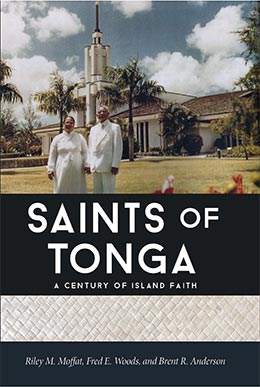From Tonga Temple Announcement to Centennial Celebration (1981-91)
Riley M. Moffat, Fred E. Woods, and Brent R. Anderson, "From Tonga Temple Announcement to Centennial Celebration (1981-91)," in Saints of Tonga (Religious Studies Center, Brigham Young University; Salt Lake City: Deseret Book, 2019), 341–366.
The Tongan Saints were elated over the announcement in 1978 that a temple would be built in American Samoa because it would greatly reduce the travel expenses for them to attend the temple. However, the announcement in the April 1980 general conference that separate temples would be built in Tonga, Western Samoa, and Tahiti occasioned even greater jubilation. Elder Tonga Toutai Paletu‘a, serving as a regional representative, had met with the First Presidency on Wednesday, April 2, to receive the news that a temple would be announced for Tonga. He recorded in his journal that he was overjoyed: “There had been much prayer and fasting among the Tongan people for this very thing.”[1]
Falaetau Mahu‘inga Fineanganofo related how the land for the temple was selected:
Grandpa Mahu‘inga instructed my father if there is ever a time that a temple will be built in Tonga, to donate his land which is the family land that would eventually be my father’s land. Grandpa passed away in 1976 before any talk of a temple in Tonga. When a temple was announced to be constructed in Tonga a committee was set up to search for land for the temple site. One evening, all our siblings and their spouses were gathered for a family home evening at my father’s home in Pea. While we were having our meeting, a knock was heard on the front door. To our surprise the Director of the Church Temporal Affairs, Brother Sione Tu‘alau Latu entered and asked to share the purpose of his visit with my family. He said that the committee has been searching in the Eastern district and also considered the land of Baron Vaea opposite Liahona High School. The committee felt that Brother Latu should talk to my father [to see] if he would consider allowing the church to purchase five acres of his family land for the building of the temple. I remembered my father telling Brother Latu that the land was already consecrated by his father, Grandpa Mahu‘inga, for this very purpose if the Church ever needed it. The land was donated to the church without making a purchase. The land was deeded back to the Noble Lavaka, who leased his property to the church for 100 years.[2]
Interestingly, the first architectural drawings showed a temple with neither spire nor an angel Moroni.[3] At this time Tonga had the highest percentage of missionaries serving, 375 out of 16,747 Latter-day Saints in the country, or 2.2 percent. No other country came close, and that is still the case.[4] Sione Tu‘alau Lātū was called as a regional representative on October 25, 1980, to replace Tonga Toutai Paletu‘a, who was called as the first president of the Nuku‘alofa Tonga Temple on April 18, 1981.
Pita F. Hopoate Replaces Sione Tu‘alau Lātū
When Pita Hopoate began his service as mission president in Tonga on July 1, 1980, Elder Adney Y. Komatsu of the Seventy half-jokingly told President Hopoate that he would not be released until he had prepared the members for a stake to be organized in the islands of Ha‘apai. Two tragedies helped prepare Ha‘apai for stakehood. After a district conference in Pangai, a number of Saints and their friends who had come to participate boarded the Fetu‘umoana to sail back to the islands of Lulunga on December 19, 1980. Conditions were nice, but at 10:00 a.m. the boat capsized between Lofanga and Ha‘afeva. Several members and missionaries perished. Police investigation revealed that the captain had removed ballast from the boat’s hull so he could take on a cargo of copra to carry to Nuku‘alofa, thus making the boat top-heavy and unsteady. President Hopoate noted, “This incident also caused hearts to be softened and more people of Lulunga islands accepted to listen to the message of the missionaries which brought about an increased number of converts to the Ha‘apai District,” preparing them for stakehood.[5]
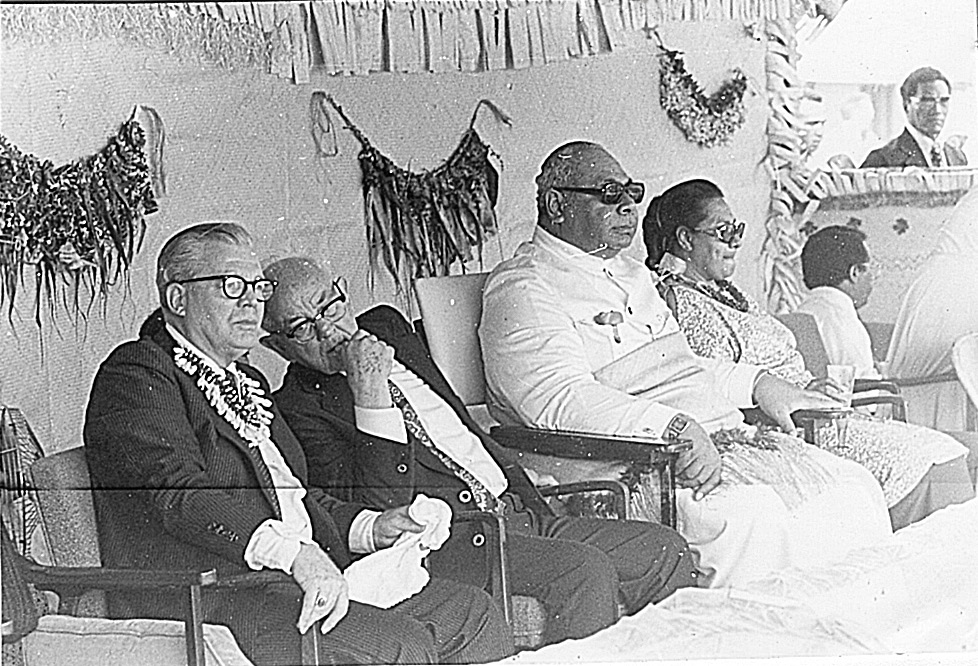 President Spencer W. Kimball and His Majesty King Taufa‘ahau Tupou IV at the groundbreaking of the temple. Courtesy of Kakolosi Kioa Tu‘ione.
President Spencer W. Kimball and His Majesty King Taufa‘ahau Tupou IV at the groundbreaking of the temple. Courtesy of Kakolosi Kioa Tu‘ione.
A second tragedy occurred when Cyclone Isaac struck Tonga on March 2, 1982, with 172 mph winds. By far the worst damage was done in Ha‘apai, where the storm leveled 90 percent of all homes. Nearly all the people sought shelter in the concrete block Latter-day Saint chapels, which sustained only minor damage. They were generally the only buildings left standing. President Paletu‘a recorded that “there was not one thing that was damaged on the Temple property,” which was then under construction.[6] In Tonga four thousand members were left destitute. Most of the crops of Ha‘apai were destroyed. Miraculously, no Latter-day Saints died in the storm. Elder Groberg recalled, “Our members’ houses suffered along with the rest of the population; but our chapels just stood out like beacons—and did not fall.” Elder Groberg noted that he was also very impressed with the faith of the members. He said, “Their attitude is basically this, . . . ‘It’s our hurricane, let us get the blessings from it. The Lord sent it to us for a purpose, and we’ll just live with it.’”[7]
On Tongatapu the storm surge flooded the mission home on the beach in Sopu, and the mission president’s family had to seek refuge on top of the water tank in the garage. President Hopoate and his family then moved into the mission office in Fasi. The Church immediately began to launch relief efforts and shipped in much-needed supplies from New Zealand, Australia, Hawai‘i, and Samoa. Church members in Tonga and elsewhere also reached out to those needing assistance. For example, to assist with relief efforts, Tongan Latter-day Saint Sister Kalo Mataele Soukop of Honolulu sent money and seventy thousand pounds of food and clothing from Hawai‘i to Tonga.[8] The official Church response was immediate, and this report soon followed:
Hurricane Isaac, which wreaked such terrible destruction, such that over 90 percent of the homes in Ha‘apai Island were destroyed, was also a blessing. As is so often the case in disaster it brought out some of the best in human behavior and demonstrated the great strength of the LDS Church. Immediately, it was noticeable that except for minor roof damage, not one LDS chapel was destroyed. They were quickly repaired and used as temporary shelters for non-members as well as members. The Church quickly allocated over a million dollars of relief funds plus large commodity shipments which were distributed through normal church procedure. . . . The whole population was so impressed by the Church members and the welfare program that missionary work surged forth.[9]
These relief efforts and the generosity of the Saints in aiding with recovery efforts caused many more people to listen to the gospel message.[10] These two tragedies helped prepare the people of Ha‘apai for a stake to be organized on June 14, 1983, and to be prepared to enter the temple.
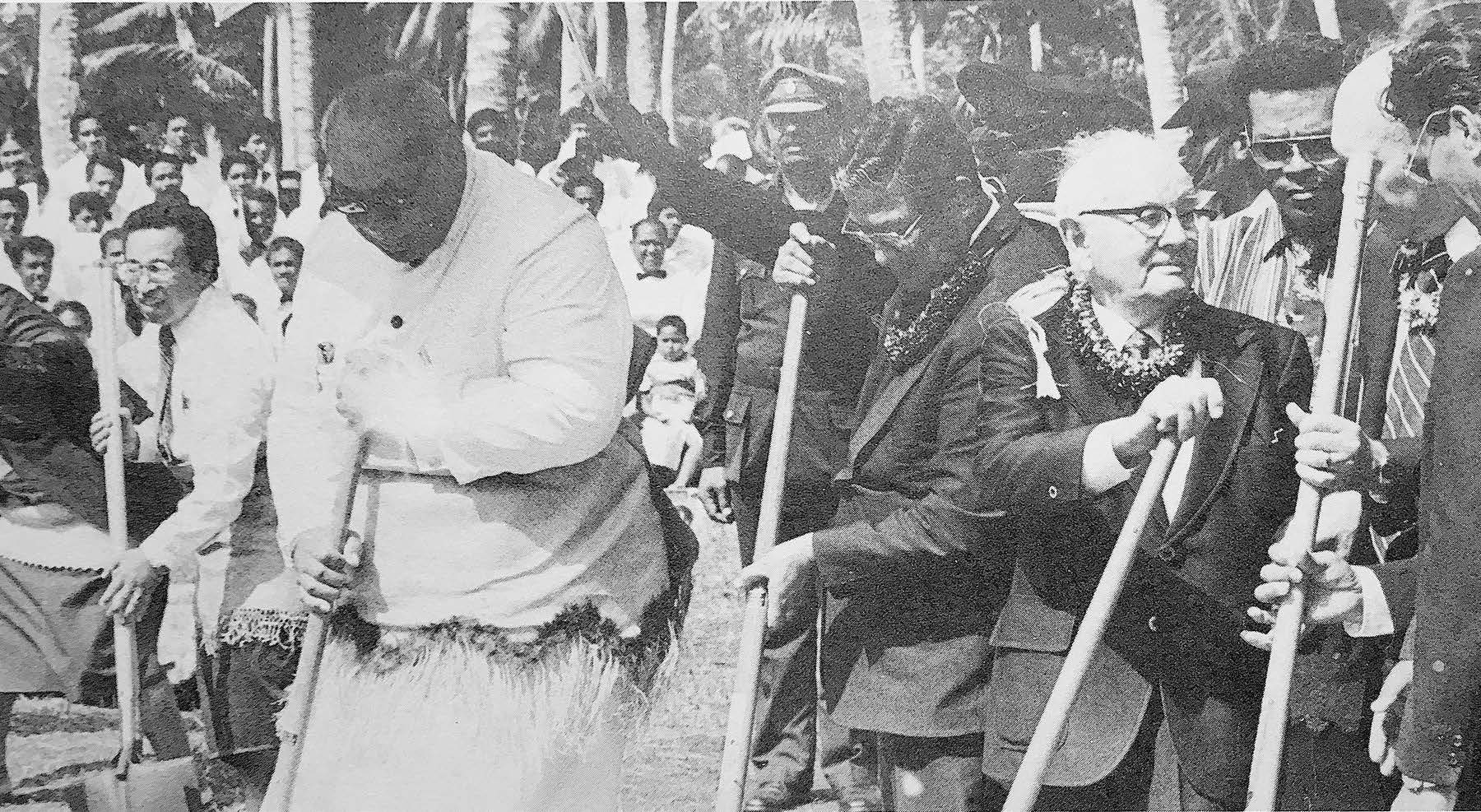 President Spencer W. Kimball and His Majesty King Taufa‘ahau Tupou IV at the groundbreaking of the temple. Courtesy of Kakolosi Kioa Tu‘ione.
President Spencer W. Kimball and His Majesty King Taufa‘ahau Tupou IV at the groundbreaking of the temple. Courtesy of Kakolosi Kioa Tu‘ione.
President Paletu‘a “lived across the street from the Temple site. He was able to observe the building of the Temple daily.”[11] When it was time in January 1981 to clear the five acres Brother Mahu‘inga had donated, the call went out and two thousand men showed up and made the work quick and easy. Elder Paletu‘a recalled that their mood was one of “happiness and joy.”[12]
Groundbreaking for the new temple occurred on February 18, 1981. President Kimball presided at the service along with Elder Komatsu. His Majesty King Taufa‘ahau Tupou IV also participated and even turned a shovel of dirt.[13] Seven thousand members and their friends attended the groundbreaking. In looking forward to the temple, the Saints of Tonga were blessed with the spirit of Elijah. As an example, Tevita Uatahausi and Kalolaine Mapa prepared sixty thousand names for temple work; most were gathered orally because Tongan written records only went back to 1872.[14]
As the time for the dedication grew near, President Paletu‘a recorded, “On the eighth of January the Angel Moroni was placed atop the Temple Tower. . . . We all wept. It was something the Tongan people had never seen. . . . It is a testimony to the Tongan people that they are part of God’s love which extends from Abraham, Isaac, Jacob, Joseph, Manasseh and then through Lehi to the Tongan people.”[15]
Temple Open House and Dedication
The temple open house ran from July 18 to 30, 1983. Prior to the public open house, the Tongan royal family and many nobles and government leaders were given a special tour of the temple on July 9. Elder and Sister Groberg served as escorts to the king and queen. After the tour, Elder Groberg explained the plan of salvation and the role of the temple in greater detail than he had done before.
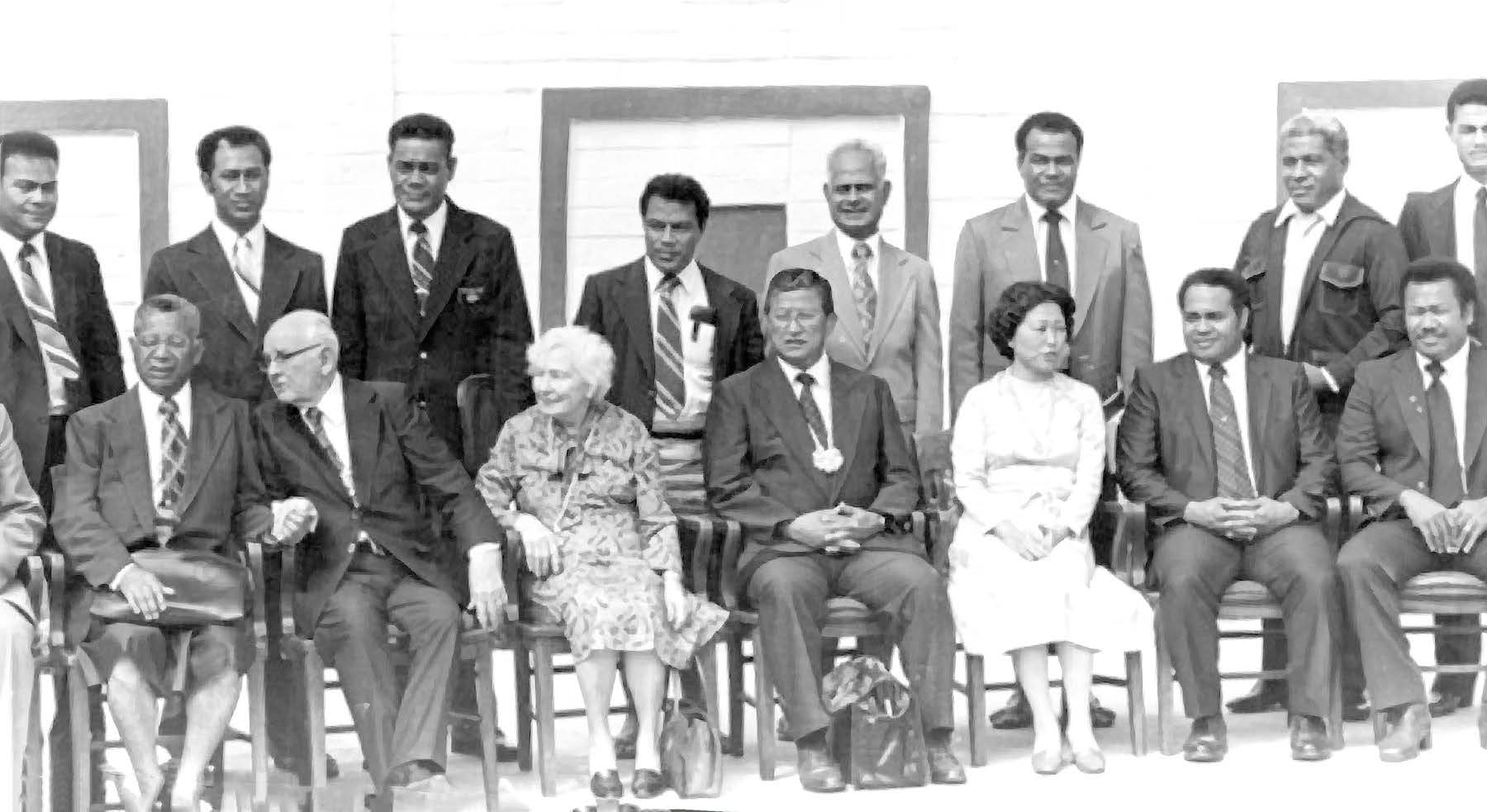 President Kimball and ecclesiastical leaders at groundbreaking. Courtesy of Kakolosi Kioa Tu‘ione.
President Kimball and ecclesiastical leaders at groundbreaking. Courtesy of Kakolosi Kioa Tu‘ione.
The Nuku‘alofa Tonga Temple was dedicated on August 9 by President Gordon B. Hinckley, First Counselor in the First Presidency. Elders Howard W. Hunter, Marvin J. Ashton, and L. Tom Perry of the Quorum of the Twelve; Elders W. Grant Bangerter and John H. Groberg of the First Quorum of the Seventy; and Bishop H. Burke Peterson, First Counselor in the Presiding Bishopric, also attended and participated.[16] The dedication continued through August 11.
The dedication celebration brought great joy to the Tongans, “with singing, dancing, feasting and fasting reminiscent of the completion of Solomon’s Temple.”[17] About four hundred Church members from Vava‘u traveled several days by boat to attend the glorious celebration. Mosese H. Langi, president of the Vava‘u Stake, said, “Some sold their produce, pigs, and other animals for the boat fare.” However, the price was well worth it as blessings were shed forth on many.[18]
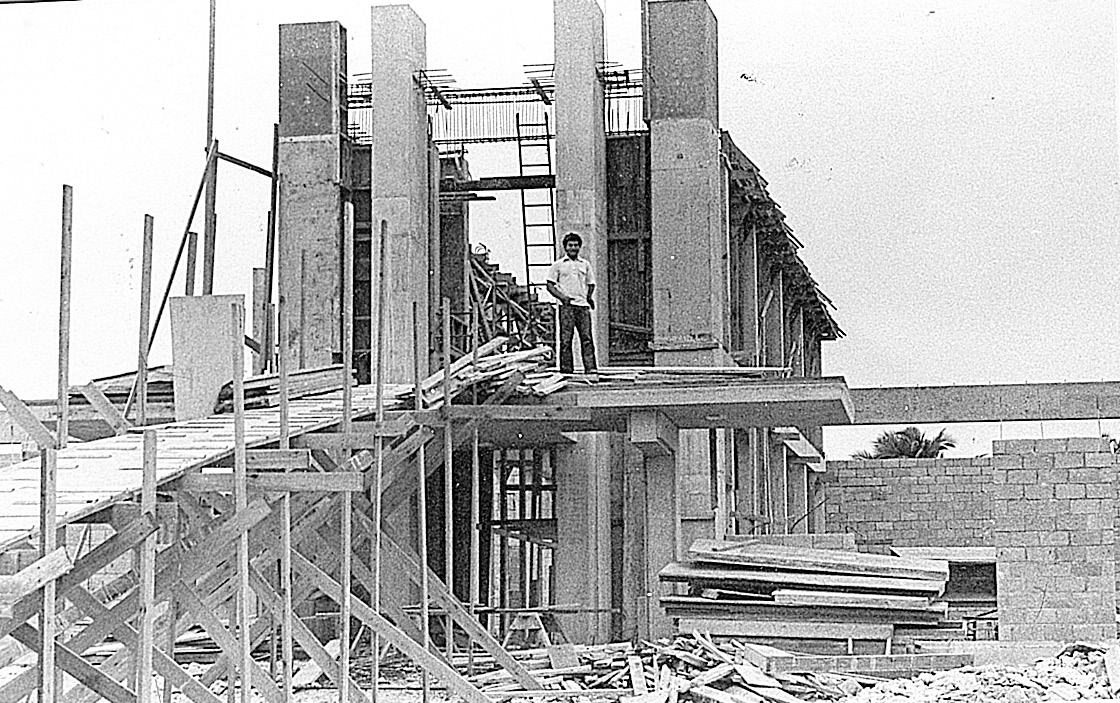 Construction of the Tonga temple. Courtesy of Kakolosi Kioa Tu‘ione.
Construction of the Tonga temple. Courtesy of Kakolosi Kioa Tu‘ione.
The dedicatory prayer extended a blessing upon the royal family and the Tongan kingdom: “We invoke Thy blessings upon the king and queen of Tonga, and upon the government of this kingdom of Tonga and those who serve therein that they may look with favor upon Thy people always and assist them in the accomplishment of the purposes Thou hast set before them to teach the gospel to all of Thy children and to build Thy Church.”[19] This blessing has found fulfillment in the support that the Tongan monarchy has extended to the Church over the past few decades, and this support has been reciprocated.
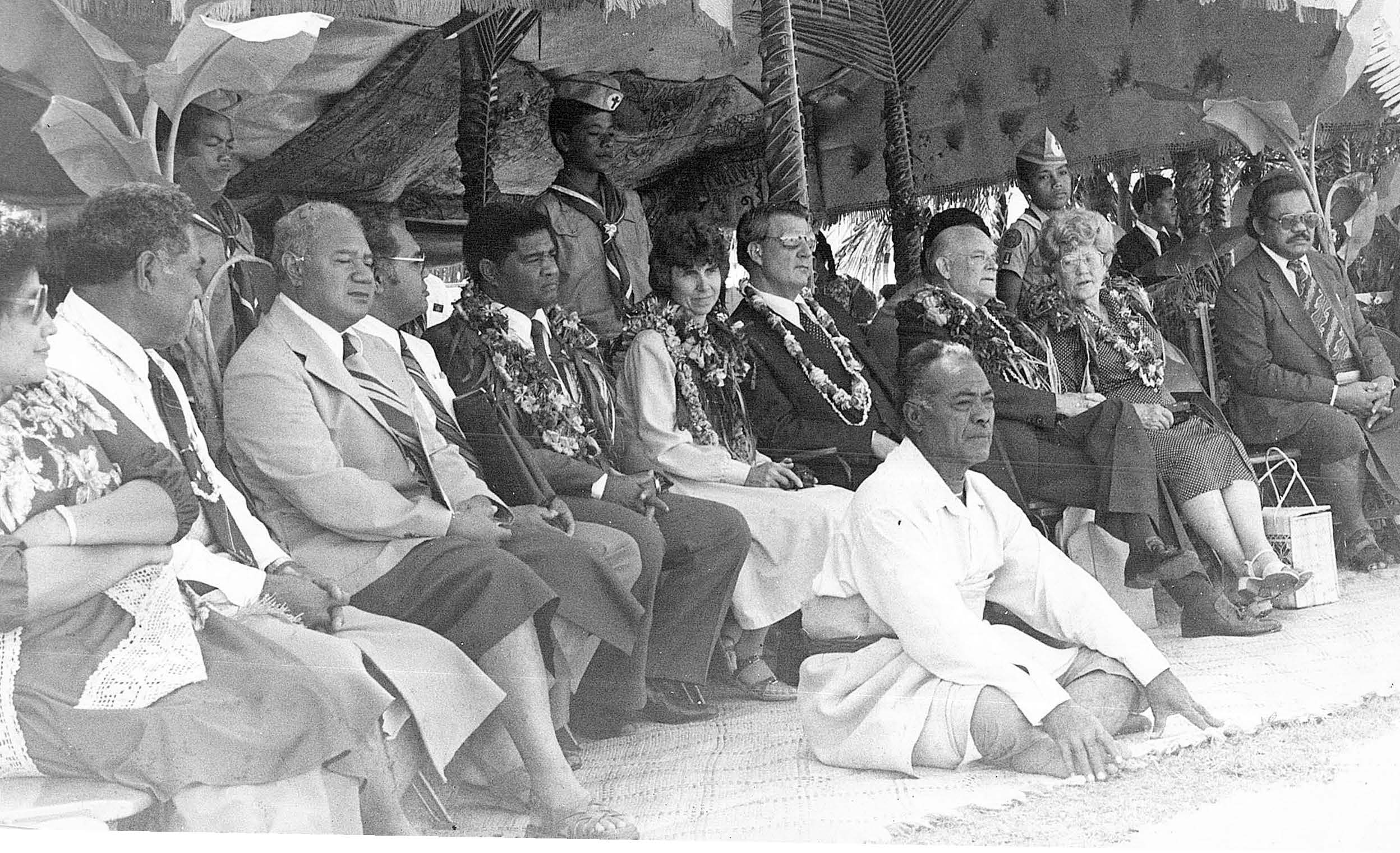 Tevita Ka‘ili, Sione Latu, Pita Hopoate, Elder and Sister Groberg, with Elder and Sister Hunter at a dedication cultural event. Courtesy of Kakolosi Kioa Tu‘ione.
Tevita Ka‘ili, Sione Latu, Pita Hopoate, Elder and Sister Groberg, with Elder and Sister Hunter at a dedication cultural event. Courtesy of Kakolosi Kioa Tu‘ione.
Among other things, President Hinckley’s dedicatory prayer noted that the Tongans were descendants from the house of Israel, as noted in the Book of Mormon, and he spoke of missionary work both to and from the island of Tonga: “We thank Thee for the coming forth of the Book of Mormon with its record of the forebears of the people of Tonga.” The prayer also expressed thanks for those who introduced the gospel nearly a century before the dedication: “We thank Thee for the missionaries who for many years have come here to bring the glad tidings of the restored gospel. We thank Thee for their faith, for their consecration, for their willingness to face the perils of the sea and long absence from their homes to serve as Thy messengers to Thy people.”
In addition, President Hinckley declared, “We thank Thee for Thy many sons and daughters of Tonga who have similarly served with great devotion.” This is most interesting when considering that in the same year that the dedicatory prayer was offered, 100 percent of the graduating class at Liahona High School accepted a call to serve a mission.[20] Historian R. Lanier Britsch wrote in his 1986 book Unto the Islands of the Sea, “No area in the world produces more missionaries in proportion to Church population than Tonga.”[21] President Paletu‘a recorded in his journal that temple work commenced on August 11 with baptisms and endowments for the dead by those who had already been to another temple. Endowments and sealings for the living followed on August 12 and sealings for deceased families on August 15. By the end of December 470 new patrons had received their own endowment.[22]
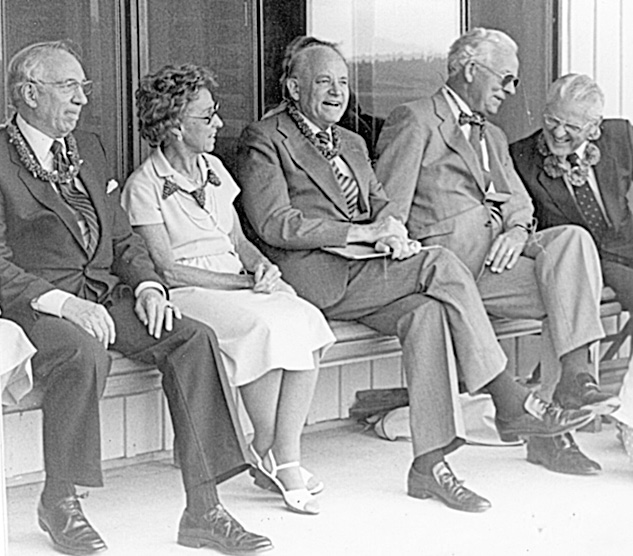 Elder Howard W. Hunter and others at the dedication of the
Elder Howard W. Hunter and others at the dedication of the
Nuku‘alofa Tonga Temple. Courtesy of Kakolosi Kioa Tu‘ione.
A particular blessing of having the temple in Tonga was that the hundreds of missionaries called in Tonga could receive the ordinances of the temple and have that knowledge and experience to help them be better missionaries. However, under the Church policies of that time, since many missionaries were being called at eighteen right after high school, they were required to wait until they turned nineteen and sisters until they turned twenty-one before they could be endowed. Nevertheless, the temple was a tremendous blessing to the missionaries.
Temple Causes Opposition
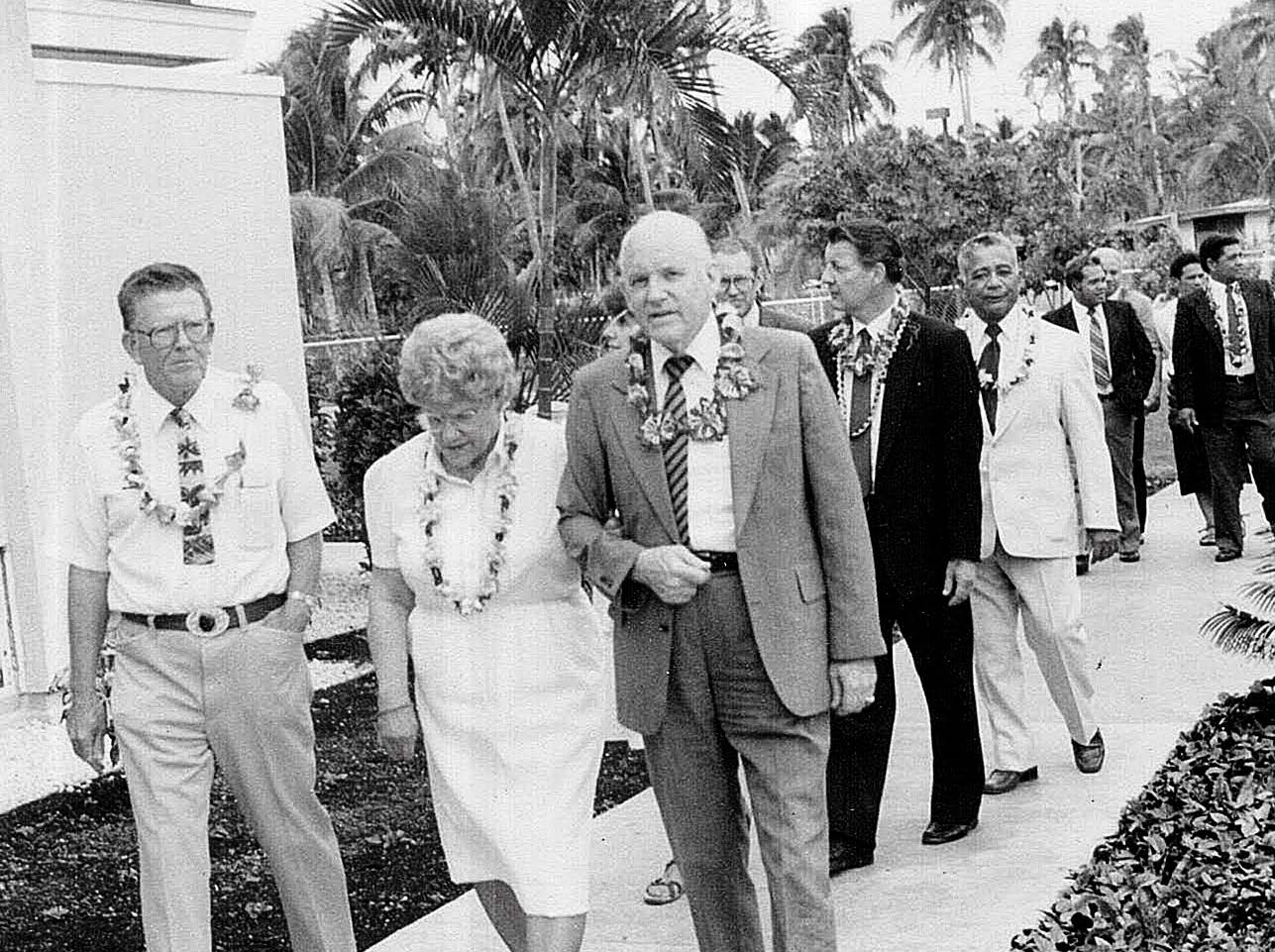 Elder Howard W. Hunter and others at the dedication of the
Elder Howard W. Hunter and others at the dedication of the
Nuku‘alofa Tonga Temple. Courtesy of Kakolosi Kioa Tu‘ione.
Following this inspiring dedication, opposition soon set in as Ed Decker, a former member from the United States and founder of Ex-Mormons for Jesus, brought his entourage to Tonga to try to sway Tongans away from the Church via oppositional films and literature. During this period of contention, mission president Melvin Butler said, “We try to ignore what they are doing. We are concerned, but we want people to judge us by the fruit of our work.”[23] Pita Hopoate recalled that Satan knew the great blessings that would come with the dedication of the temple, so the members were not surprised when individuals not friendly to the Church started coming in with Decker to show antagonistic films about the temple.[24]
In an interview following his visit to Tonga, Decker boasted that he had shattered the work of the Church in Tonga. Decker stated, “I think the work we did there in Tonga totally put an end to Mormonism.” What happened was just the opposite. President Butler recalled, “All this caused people to look into the Church. Many of the nonmembers that would see this would say, ‘Hey, my neighbor here is a Mormon, he wouldn’t do that. He’s not that kind of a person. He wouldn’t do that.’ . . . That made them more curious about what really was true about the temple. And so it turned out to be a blessing in disguise, you know, in the way that it happened.”[25] In 1984—the year of Decker’s visit—the Church had 1,454 convert baptisms in Tonga and more than 800 during the first half of the following year.[26]
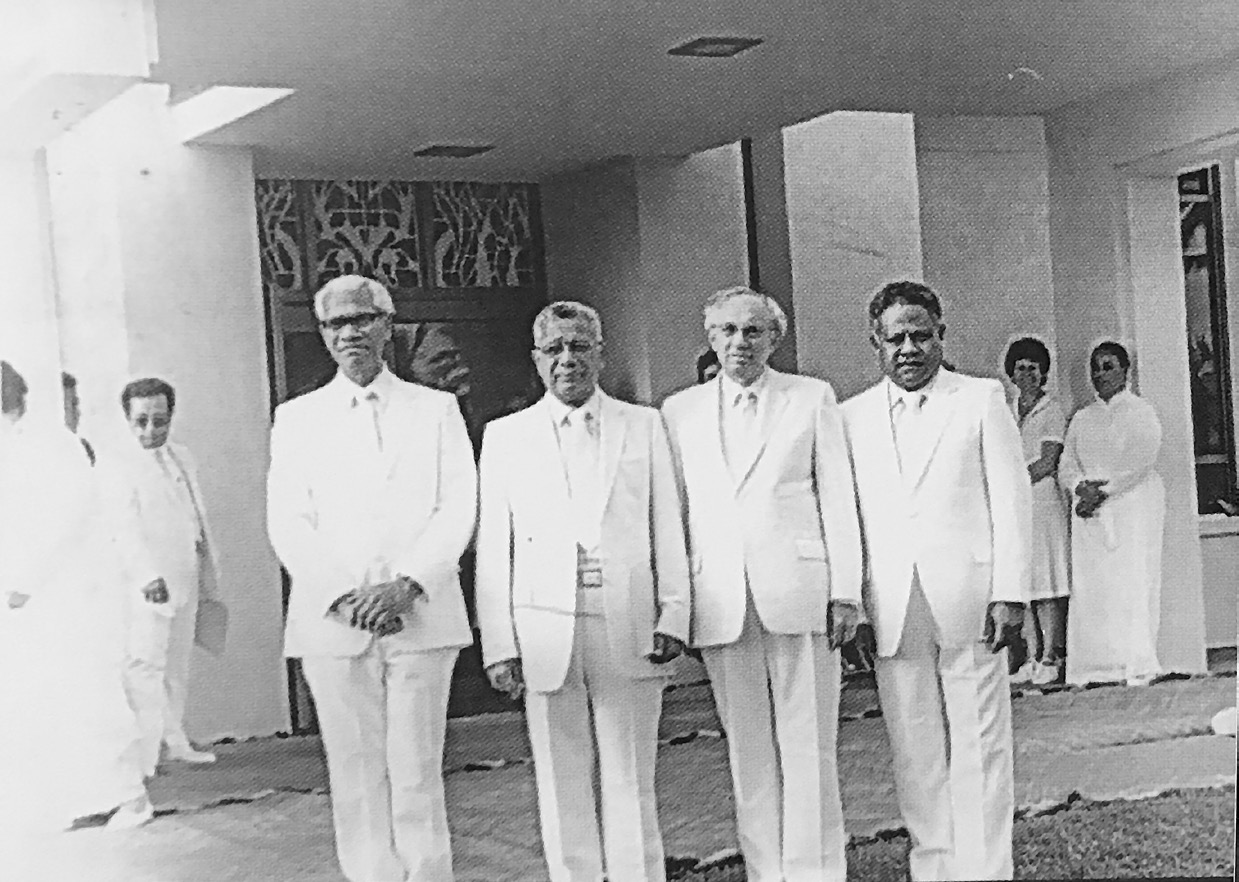 First Tongan Temple presidency: Vaha‘i Tonga 1C, President Tonga Toutai Paletu’a, President Gordon B. Hinckley, Filimoni Fie‘eiki 2C. Courtesy of Kakolosi Kioa Tu‘ione.
First Tongan Temple presidency: Vaha‘i Tonga 1C, President Tonga Toutai Paletu’a, President Gordon B. Hinckley, Filimoni Fie‘eiki 2C. Courtesy of Kakolosi Kioa Tu‘ione.
One member influenced by the Decker film was Sione ‘Olei Piutau Tupou. Instead of being pushed farther away from the Church of Jesus Christ, Tupou returned to the Church after being absent for forty-six years. He recalled the following when one of Decker’s antagonistic films[27] came to his Tongan village:
On the appointed day and hour, I sat in the community club watching people lined up to see the film, feeling very disgusted and depressed that a church with so much good would be publicly attacked. . . . I suddenly felt the presence of my father and mother, who had been dead these many years. I broke down, unable to control my tears, and surprised my fellow club members by standing up and going home. . . . On Sunday I . . . walked to the chapel. The Saints were as surprised to see me as members of my former church were bitter to see me go. I have not missed a Church meeting since.[28]
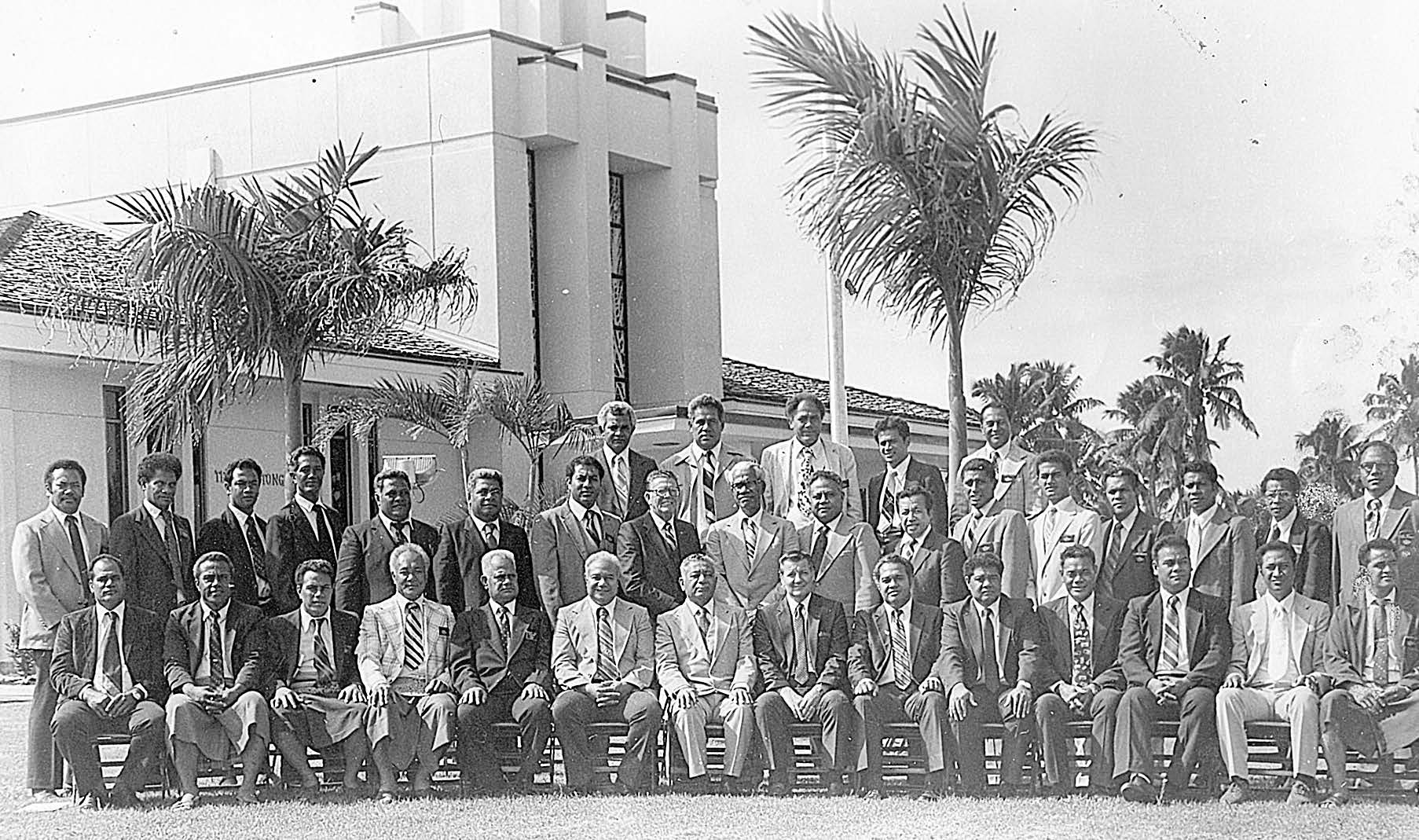 Elder John Groberg and ecclesiastical leaders at the time of the temple dedication. Courtesy of Kakolosi Kioa Tu‘ione
Elder John Groberg and ecclesiastical leaders at the time of the temple dedication. Courtesy of Kakolosi Kioa Tu‘ione
Pita Hopoate recalled that to defend the temple and the Church many members had to learn more about the temple, which strengthened their testimonies. Fortunately, not as many members left the Church as Decker had hoped, while many new members joined after they learned the truth. In fact, less-active Church members stepped forward to defend the Church against Decker’s entourage, sometimes forcefully. As is common around the world, members may not be active and may have challenges living the gospel, but they will defend the Church they know to be true. In one case, a member of another faith named Sione Tu‘ipulotu, who was married to a member and had friends that were good members, couldn’t believe the negative propaganda he heard and, after investigating, he joined the Church. The good examples of members had a positive effect in counteracting the negative propaganda of Ed Decker and his friends.[29]
Growth continued through 1985 and the second Tonga area conference was held at Liahona in which 13,000 Saints attended as well as several General Authorities. Growth continued under the leadership of President Eric B. Shumway, who was called to replace President Butler in July 1986. President Shumway, who had served a mission in Tonga as a young man, was ready to take the reins and move the work forward.
Eric B. Shumway Strengthens Ties with the Royal Family
While setting apart President Shumway, Elder Marvin J. Ashton specifically charged him and his wife, Carolyn, “to restore feelings of goodwill with government leaders and reestablish relationships of trust with the royal family.” This was needful as negative feelings from the general population had arisen, stemming mostly from Ed Decker’s film The God Makers. The result was that positive relationships that had been forged over many years were strained and, in some cases, broken.[30] Therefore, President Shumway set goals to strengthen his young missionaries, most of whom were native Tongan youth, both young men and young women. In a society that valued maturity, these missionaries were viewed with skepticism because of their youth. The Shumway family was also committed to teach the gospel by word and deed so that their example would match their message. For example, scores of investigators gathered each Thursday night at the Shumway residence—Church films were shown, missionary talks were given, and the audience was entertained by the talented Shumway family. During the Shumways’ three-year mission, such meetings included consistent family home evenings and regular firesides and accounted for nearly ten thousand visitors at the mission home. This program of having firesides in the mission home for investigators and members of other faiths also proved successful for President Mark Vernon Coombs in the 1920s.
An important lesson President Shumway had learned through his earlier Tonga missionary labors was, as he explained, “to take advantage of all the ceremonial opportunities to inculcate in our missionaries a respect of their country’s great heritage and to ingratiate themselves among the larger population through community service and polite participation in ngaahi ‘apisia (public events such as funerals).” Efforts were also extended to the community via thirty-minute Church programs aired every Monday evening over Tongan radio. These messages came from local Tongan Church leaders who took turns sharing gospel messages.[31]
Building on the good work of President Butler, by the end of President Shumway’s first year as the new president, the mission had over one thousand baptisms.[32] By the end of 1987, efforts to build bridges with the hou‘eiki were paying off. For example, President Shumway arranged for nearly one hundred of his missionaries to gather at the palace during the Christmas holiday season to hold a devotional for King Tupou IV. The missionaries, who were mostly native Tongans, sat on the lawn of the palace and began to sing as the king entered the large palace porch. President Shumway recalled, “The missionaries were a stunning sight and their singing was beyond description. I sensed His Majesty’s surprise and joy.” One of the hymns sung was “Called to Serve.” For this special, royal occasion, one of the sister missionaries had produced a translated version that included the phrase, “Raise your voices, sing gratitude. And bless, bless, our King,” in the chorus. Shumway later learned that King Tupou IV was surprised and delighted to learn there was a Church hymn that included a blessing to him.[33] In 1988 convert baptisms reached fourteen hundred.[34]
This same year, another devotional was held for the king at his Fua‘amotu residence near the airport. In a journal entry dated April 27, 1988, President Shumway recorded the following about this unique and inspiring occasion:
We [about sixty Tongan missionaries] waited briefly outside the King’s quarters, then, as invited, the missionaries reverently walked into the room where the King was waiting. . . . The King’s herald or matapule, To‘amalekini, sat on the floor on the King’s left. After greeting the King, I began with a formal acknowledgment. . . . I mentioned we were there to express our love and to worship with him. . . . It is hard indeed to describe the beauty of the missionaries as they sat at the foot of their king. . . . They had come into the room, clean, orderly, and sat close to each other. Their faces shone with a brightness and sweetness that will long live in my memory. Their first song was “Come, Come, Ye Saints” after which I read from John Chapter 14. I then spoke on Nephi’s wonderful testimony of Christ, “We talk of Christ, we rejoice in Christ, we preach of Christ, we prophesy of Christ and we write according to our prophecies,” etc. (2 Nephi 25:25–26). The moment I said Amen, the missionaries raised the sacred strains of “O My Father.” After the hymn I knelt with my counselor, Bill Afeaki, who offered a beautiful prayer. The King was animated, if not downright joyful. The King’s herald chief, To‘amalekini, then spoke for the King to the missionaries: “You are the servants of the Lord. We honor you because at the most difficult time of your life when the carnal forces are coursing through you the most fiercely, you are able to covenant with the Lord to do his work and to give up the pleasures of youth to serve him with might and with dignity.”[35]
Another special event during President Shumway’s ministry occurred just two months later when Elder James E. Faust visited Tonga and, during a special family home evening held in the Havelu Stake Center on June 19, 1988, pronounced from the pulpit an inspired apostolic blessing upon King Taufa‘ahau Tupou IV and Queen Halaevalu Mata‘aho. The blessing by Elder Faust contained the following words:
As an apostle of the Lord Jesus Christ, I should like to invoke an apostolic blessing upon Your Royal Majesty and pray that the Spirit of our Heavenly Father will be on your right hand and be on your left hand, that his Spirit will be in your hearts and his angels round about you. I invoke a blessing upon Her Majesty the Queen, and upon your family, and upon all your subjects of these great and blessed islands. We are grateful for noble kings and queens in these islands who have permitted their subjects to worship God according to the dictates of their conscience. And I bear you this humble witness and invoke these blessings upon you, and do so in the name of Jesus Christ, Amen.[36]
Thus, the royal family and all the Kingdom of Tonga were blessed by Elder Faust, and they were also blessed by the exceptional service of President Shumway. Just two months before he was to be released, he visited Siaosi ‘Akau‘ola, the honorable minister of police, then recorded this journal entry dated May 2, 1989:
The purpose of the visit was to introduce the new mission president, ‘Isileli Kongaika, and to present the Minister with a copy of the second edition of my book, Intensive Course in Tongan. President Kongaika was delayed so I was able to chat at some length with Minister ‘Akau‘ola. He was complimentary as usual and expressed his gratitude for the LDS Monday night radio program. . . . I was most gratified by his comments that in the three years of our tenure, every vestige of anti-Mormon sentiment, at least in public displays, has been silenced by the power and the goodwill of our radio program and our visibility. He said, “You have closed the gap between us and healed the wounds.” He also said he had not heard any negative, only positive comments about the Church from his various sources. I took that to include the Cabinet and the Royal family.[37]
No doubt, President Shumway felt much joy and satisfaction from this incident. He was indeed a blessing to the Tongan people during his years as mission president (1986–89) and subsequent service.[38] Likewise, the Tongan Saints have blessed him. Reflecting on his life, President Shumway said, “So much of my life has been defined by the faith of the Tongan people. So much of what I learned about leadership I received from the Tongan people. So much of what I’ve learned about hospitality I’ve learned from the Tongan people. And I’ve gathered these things over the years, and I’m grateful to give back to the Tongan people what they gave to me.”[39]
‘Isileli Tupou Kongaika Replaces Eric B. Shumway
On July 1, 1989, ‘Isileli Tupou Kongaika replaced Shumway as mission president. Concerning this transition, President Shumway wrote:
As a final event to help bring about a seamless transition from the Shumway administration to that of the new Tongan mission president, Isileli Tupou Kongaika, we held a combined farewell and welcome luau at the mission home. We invited people who represented all levels of the Tongan society and dozens of [expatriates]. Many came to the event, including those who had been adversaries of the church before. President Bill Afeaki was the Master of Ceremonies. As an expert in Tongan protocol he was able to acknowledge each guest with dignity and grace. Carolyn and I were able to speak our farewells, but it was President Kongaika who stole the show with his perfect English and his wit. He spoke with clarity, even brilliance.[40]
President Kongaika had also been influenced by Eric Shumway. They were already dear friends because Brother Kongaika had served as a counselor to President Shumway in the mission presidency. President Kongaika, a great-great-great-grandson of Taufa‘ahau, King George I, recalled this special time presiding over the mission, noting that “the growth I had personally was amazing to me, because I don’t think anyone would know, would even consider the little boy from Ha‘apai would amount to something. But I think the Lord knew where my heart was.”[41]
Under his faithful influence, convert baptisms continued to rise. By the end of 1989, there were over two thousand convert baptisms in Tonga. A new missionary training center with its own space was dedicated in Liahona, presided over by President Pita Hopoate. By the dawn of 1990 the Church began to prepare a ten-day centennial commemoration of the arrival of the first missionaries to Tonga that would be held in August 1991.[42]
Centennial Celebration
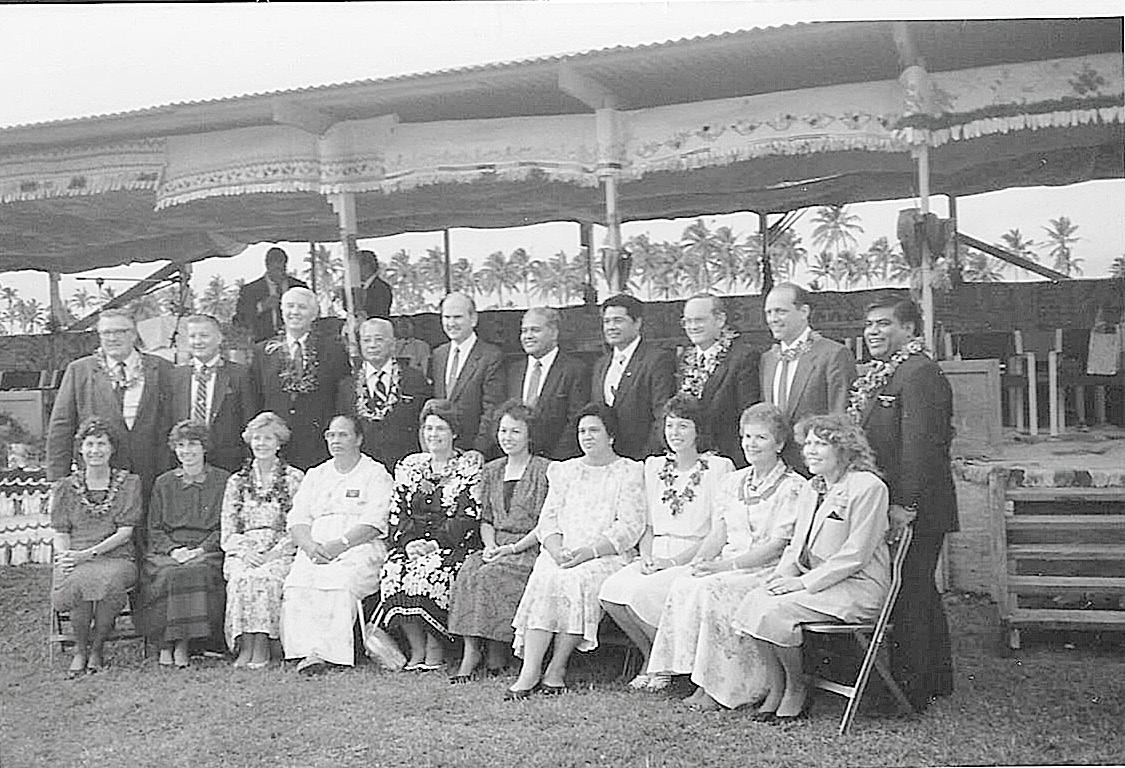 Elder Russell M. Nelson with former mission presidents at centennial celebrations. Eric
Elder Russell M. Nelson with former mission presidents at centennial celebrations. Eric
Shumway.
Members in ten stakes in Tonga devoted nearly a year in preparation for the celebration that was held August 13–27, 1991. President Kongaika felt it was a great blessing to be serving as mission president during this inspiring commemorative period.[43] On another occasion he said, “The centennial . . . was the greatest open house we ever had. It brought the Church out of obscurity.”[44] Grand celebrations were held in Tongatapu, Ha‘apai, and Vava‘u. Church News editor John Hart summarized the festivities, noting there were “three conferences, nine programs, five dances or balls, two dance festivals, five cultural dances, four sporting events, a parade, several marches, a wreath laying and visit to the royal palace, temple sessions and 11 feasts. . . . Elder Douglas J. Martin of the Seventy wryly observed, ‘It is not a good year to be a pig in Tonga.’”[45]
Elder Groberg, who had known the royal family for decades, was a host to the king and queen at the festivities. Nearly three thousand Latter-day Saint youth from seven stakes participated in a dance festival that Elder Groberg thought impressed the royal family. The youth were introduced to the king and queen as “the future of Tonga.”[46] During the commemoration, Elder Groberg publicly thanked the king and queen for their support of religious freedom in the Kingdom of Tonga. The king even declared August 19 an official holiday to honor the centennial, and the post office issued two stamps to commemorate the occasion.
Elder Russell M. Nelson and his wife, Dantzel, were also present for the entire celebration. Representing the Church as an Apostle, Elder Nelson presented a substantial gift to the Tongan citizens in the form of hospital supplies and equipment aimed at helping people of all faiths. He noted, “I was very favorably impressed with the spirit of religious tolerance and the importance of religious plurality in the Kingdom of Tonga.” He was impressed by the leaders of other faith traditions who took part in preparations for the commemoration, including food for the feasts as well as attending some of the events. Elder Nelson indicated that what occurred in Tonga could be a “marvelous example” for all mankind. He said, “I was really pleased to see this model of tolerance and mutual cooperation in Tonga.”[47]
As the rain fell upon the Tongan Saints during the official centennial conference, so did revelation from the mouth of Elder Nelson. After thanking the congregation for their “great example as Latter-day Saints,” he pronounced a blessing upon the local Church members “that from this island kingdom, faith may radiate through the entire world and affect the lives of people all over the world.”[48] In fact, Tongan Church members also held commemorative activities during the summer in New Zealand, Hawai‘i, Utah, and in both northern and southern California.[49]
The year 1991 marked one hundred years since The Church of Jesus Christ of Latter-day Saints planted seeds in the Kingdom of Tonga. The Church had grown from the proverbial mustard seed to a vibrant assembly of stakes, wards, and branches with a mission and a temple, all faithfully led by inspired Tongan leaders. They were faithful and respected citizens in a peaceful kingdom of beautiful tropical islands—they were raising strong families, being blessed with all that the gospel of Jesus Christ offers, and looking forward to a glorious future.
Notes
[1] Siope Lee Kinikini and Tangiteina Paletu‘a Kinikini, Building the Nuku‘alofa Tonga Temple: Perspectives of a Temple President (self-published, 2007), 7.
[2] Falaetau Mahu‘inga Fineanganofo and Sione M. Fineanganofo, interview by Brent Anderson and ‘Isileli Tupou Kongaika, 2018. Mahu‘inga had leased the land from Lavaka, who in turn leased it to the Church.
[3] “Church Launches Worldwide Temple-Building Emphasis with Announcement of Seven New Temples,” Ensign, May 1980, 102–3.
[4] “Percentage of Church Population Serving Missions,” Church News, June 14, 1980, 11.
[5] Pita F. Hopoate and ‘Isileli Kongaika, interview by Brent Anderson, 2018.
[6] Kinikini and Kinikini, Building the Temple, 12.
[7] “Tonga Cyclone Brings Destruction, Strengthens Faith,” Ensign, May 1982, 111–12.
[8] “Chapters of Loving Service,” Ensign, January 2000, 68–69.
[9] R. Lanier Britsch, Unto the Islands of the Sea: A History of the Latter-day Saints in the Pacific (Salt Lake City: Deseret Book, 1986), 490. An article titled “LDS in Tonga Safe but Battered after 170-mph Storm,” Church News, March 13, 1982, 11, noted, “The 172-mile-per-hour winds and heavy waves destroyed much of the island’s kingdom’s agricultural crops and damaged many thatched or tin-roofed dwelling places of the islanders.”
[10] “Tonga Cyclone Brings Destruction, Strengthens Faith,” Ensign, May 1982, 111–12.
[11] Kinikini and Kinikini, Building the Temple, 7.
[12] Kinikini and Kinikini, Building the Temple, 9.
[13] The article “President Launched a New Era,” Church News, November 10, 1985, 4, shows a picture of President Kimball and the Tongan king, side by side, turning the soil over with shovels at the temple groundbreaking ceremony on February 18, 1981.
[14] “Couple Talks, Listens to Uncover History,” Church News, June 27, 1981.
[15] Kinikini and Kinikini, Building the Temple, 18.
[16] “Temples Dedicated in Samoa, Tonga,” Ensign, October 1983, 75–77.
[17] Gerry Avant, “Tongans Sing, Dance, Weep at Dedication,” Church News, August 14, 1983, 3. Designed by architect Emil B. Fetzer, the Nuku‘alofa Temple consists of “12,500 square feet; three sealing rooms, two ordinance room; total rooms 31,” as noted in “Nuku‘alofa Tonga Temple,” Church News, March 16, 1989, 17.
[18] Avant, “Tongans Sing, Dance, Weep,” 7.
[19] “Prayers Offer Praise, Thanks,” Church News, August 14, 1983, 4. The entire dedicatory prayer is provided in this article.
[20] Britsch, Unto the Islands of the Sea, 487.
[21] Britsch, Unto the Islands of the Sea, 485.
[22] Kinikini and Kinikini, Building the Temple, 18.
[23] Pesi Fonua, “Religious War in Tonga,” Islands Business, October 1984, 45–46.
[24] Hopoate and Kongaika, interview, 2016.
[25] Melvin Butler, interview by Brent Anderson and Riley Moffat, 2018, transcript in possession of the authors.
[26] Michael White, “Former Mormon Now One of Church’s Most Vocal Critics,” AP News, October 5, 1985, https://
[27] Fonua, “Religious War in Tonga,” 45–46, noted there were two films shown in Tonga—first The God Makers and six months later Temple of the God Makers. It appears that Tupou watched only the first film.
[28] Eric B. Shumway, “A Heritage of Faith,” Ensign, August 1995, 35. Also in Shumway, Tongan Saints: Legacy of Faith (Laie, HI: Institute for Polynesian Studies, 1991), 292–93.
[29] Hopoate, interview, 2018.
[30] See also Eric B. Shumway’s forthcoming book, Pilgrimage and Parable: The Memoirs of Eric B. Shumway (Orem, UT: n.p., 2019). The situation could have been worse, but the Saints stood strong. Pasi Havea, a Latter-day Saint police officer who was in charge of the immigration office that day, recalled that when this unfriendly group came to extend their visas so they could cause additional trouble, he refused to stamp their passports. He felt it was providential that he was in a place to curtail the negative efforts of Decker’s entourage to further spread their falsehoods. Pasi Havea, interview by Fred E. Woods, March 4, 2019.
[31] Material from Shumway’s forthcoming book, Pilgrimage and Parable.
[32] Shumway, Tongan Saints, xxx–xxxi. There was a surge in reactivation in 1986. That year temple work continued to yield more fruit. For example, Tongan Saints from the Neiafu Vava‘u Tonga Stake traveled hundreds of miles by sea to perform six thousand endowments at the Nuku‘alofa Tonga Temple. See “Tongans Travels Sea to the Temple,” Church News, August 13, 1988, 13.
[33] Content from Eric B. Shumway’s forthcoming book, Pilgrimage and Parable.
[34] Shumway, Tongan Saints, xxxi.
[35] Content from Shumway’s forthcoming book, Pilgrimage and Parable.
[36] Shumway, Tongan Saints, xi–xii.
[37] Eric B. Shumway journal, May 2, 1989, cited in his forthcoming book, Pilgrimage and Parable.
[38] For more about the life and extensive influence of Eric Shumway on Tonga and beyond, see his forthcoming book Pilgrimage and Parable.
[39] Eric B. Shumway, interview by Fred E. Woods and Martin Andersen, Orem, Utah, March 9, 2018.
[40] Material from Eric Shumway’s forthcoming book, Pilgrimage and Parable.
[41] ‘Isileli Tupou Kongaika, interview by Brent Anderson, February 5, 2018. In a later interview conducted with ‘Isi by Fred E. Woods, September 28, 2018, he talked about how his early life was greatly influenced by attending the Liahona High School. He said, “Liahona was a light to me. . . . It was a compass.”
[42] Shumway, Tongan Saints, xxx–xxxii.
[43] Kongaika, interview.
[44] John L. Hart, “Work Goes Forth,” Church News, February 1, 1992, 8.
[45] John L. Hart, “Celebrating 100 Years in Tonga,” Church News, August 31, 1991, 3, 9.
[46] “Tonga Marks LDS Centennial with Nationwide Celebrations,” Ensign, November 1991, 106.
[47] “Tonga Marks LDS Centennial,” 106–7.
[48] Hart, “Celebrating 100 years in Tonga,” 9.
[49] Hart, “Celebrating 100 years in Tonga,” 3. The commemorative events in the United States were held in July 1991. The one in Utah was held July 28 in the Tabernacle. On this occasion, President Monson as well as Elders Wirthlin and Groberg spoke about the blessing the gospel has brought to Tonga. At a fireside held the week before in northern California, about five thousand people listened to Elder Groberg say that the centennial anniversary not only honored the first Latter-day Saint missionaries to Tonga, but also “the faithfulness of the Saints during those one hundred years.” He further noted, “The Tongan people have great faith. They have the ability to bring down the blessings of heaven.” See “Centennial of LDS Arrival in Tonga Celebrated,” Ensign, October 1991, 77–78. See “Princess and 5,000 Islanders Celebrate Tongan Centennial,” Church News, July 27, 1991, 11, for more details concerning this event.
